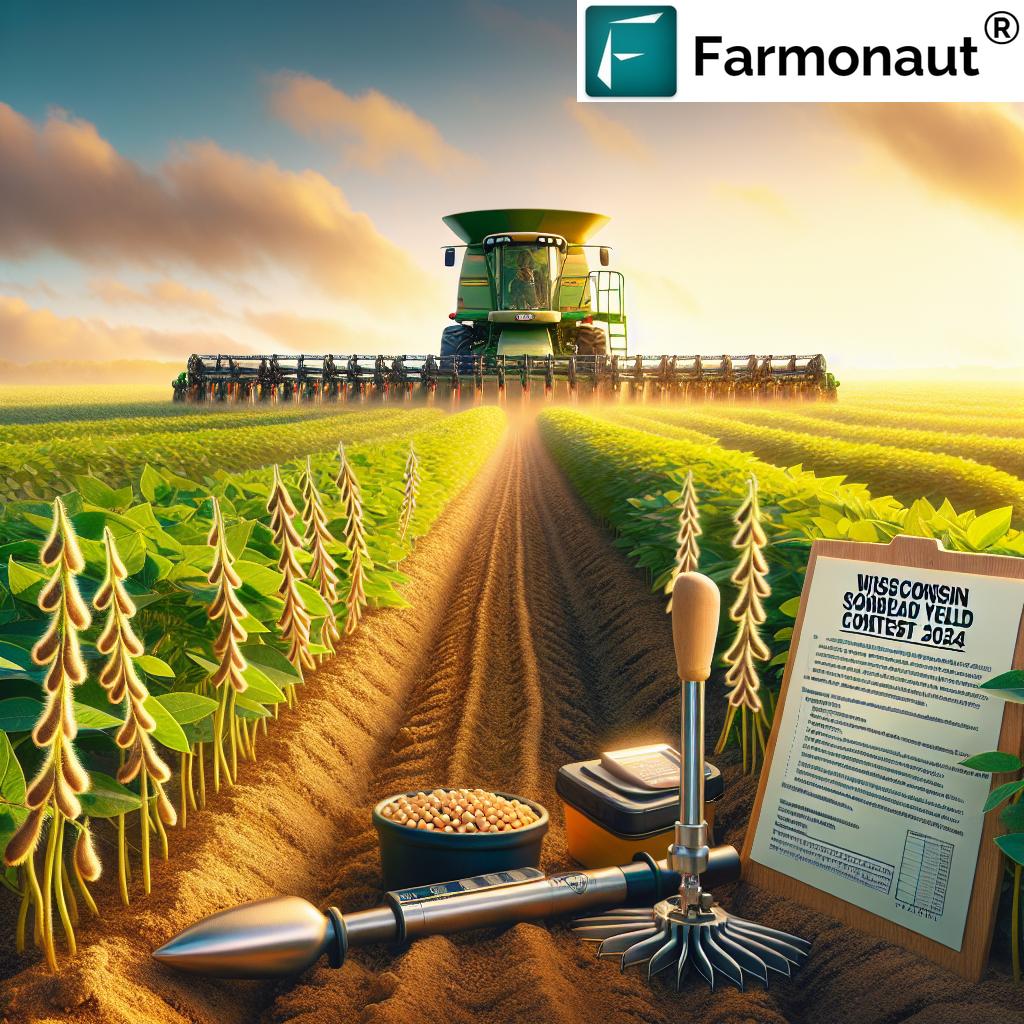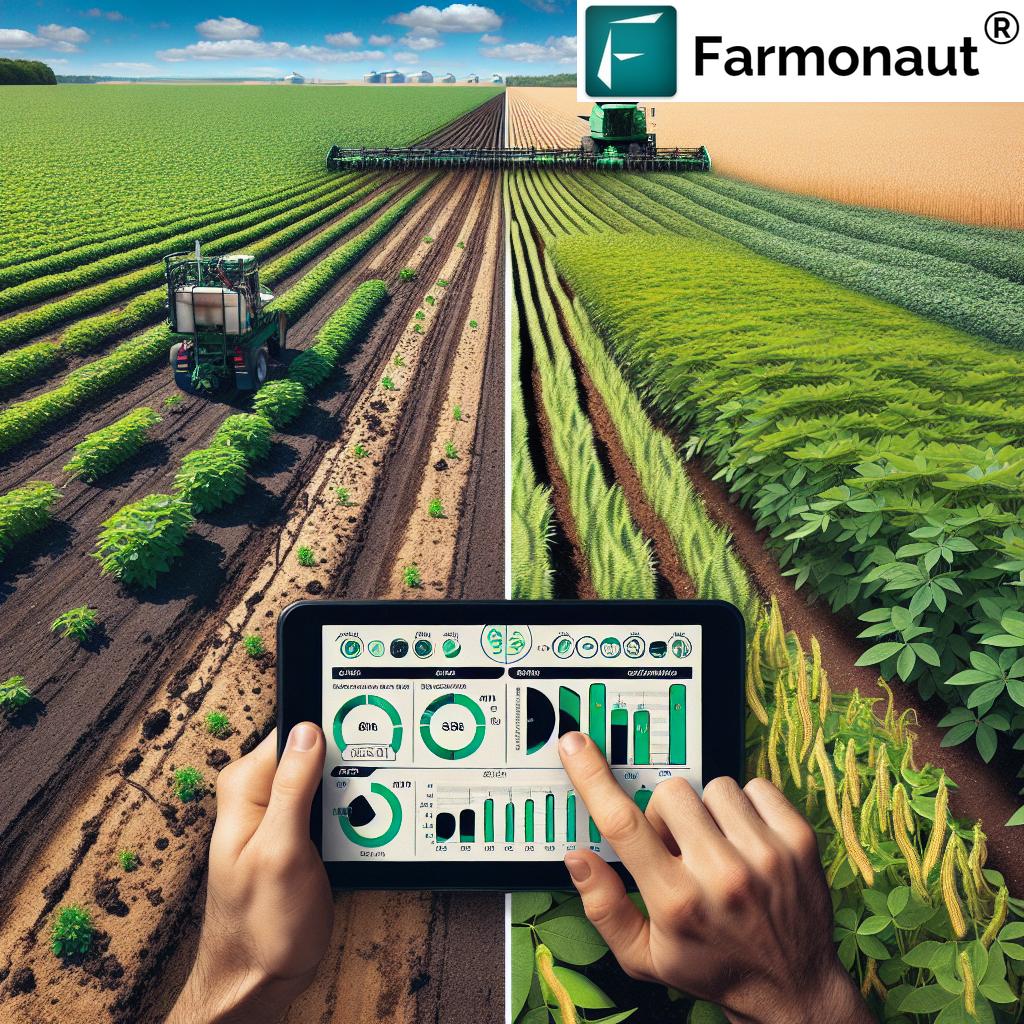Wisconsin Soybean Yield Contest: Top Strategies for Record-Breaking Harvests
Welcome to our comprehensive analysis of the 2024 Wisconsin Soybean Yield Contest, where we’ll explore the innovative farming practices and record-breaking yields that have set new benchmarks in the industry. As we delve into the strategies employed by top performers, we’ll uncover valuable insights for farmers looking to boost their soybean yields and embrace sustainable agricultural practices.

“Wisconsin Soybean Yield Contest winners achieved yields exceeding 98 bushels per acre, showcasing innovative farming practices.”
The 2024 Wisconsin Soybean Yield Contest: A Year of Innovation and Growth
The 2024 Wisconsin Soybean Yield Contest has proven to be a landmark year for soybean production in the state. With a 15% increase in participation compared to the previous year, this contest has not only showcased the passion of producers for refining their practices but also highlighted the industry’s growing focus on sustainability and efficiency.
Top performers in the contest achieved yields exceeding 98 bushels per acre, demonstrating the effectiveness of early planting, proper fertility management, and advanced weed control strategies. These impressive results underscore the potential for high-yielding soybean varieties when coupled with optimal management practices.
Key Factors Contributing to Record-Breaking Yields
- Early Planting: Many winners emphasized the importance of planting as early as possible to maximize the growing season.
- Soil Health: Cover crops and no-till farming practices were frequently cited as crucial for maintaining and improving soil quality.
- Fertility Management: Precise nutrient application, often based on soil testing and variable-rate technology, played a significant role in achieving high yields.
- Weed Control: Advanced herbicide programs and timely applications were key to managing problematic weeds like waterhemp.
- High-Yielding Varieties: Selection of soybean varieties suited to local conditions and with high yield potential was a common thread among winners.
Let’s dive deeper into the strategies employed by the top performers in each division of the contest.
Division Winners and Their Winning Approaches
| Rank | Farmer Name | Yield (bushels/acre) | Division | Key Strategies |
|---|---|---|---|---|
| 1 | Don and Doug Midthun | 98.54 | 3 | Early planting, variable-rate fertility, micronutrient focus |
| 2 | Dan Kamps | 96.76 | 4 | Strip-tillage, early planting, foliar feeding |
| 3 | John Webb | 91.79 | 2 | Early drilling, irrigation management, expert agronomic support |
| 4 | Emily Sleik | 88.8 | 1 | High seeding rate, balanced fertility, fungicide application |
| 5 | Tom Novak | 85.22 | Planting Green | Cover crops, no-till, planting green technique |
Division 3 Winners: Don and Doug Midthun
The Midthun brothers from Arlington achieved the highest overall yield in the contest with 98.54 bushels per acre. Their success can be attributed to:
- Variable-rate fertility program based on soil testing
- Early planting (April 21) with a population of 125,000 seeds per acre
- Focus on micronutrients and sulfur in their fertility package
- Effective weed management targeting waterhemp
- Use of 30-inch rows for optimal canopy development
The Midthuns’ approach demonstrates the importance of precision in every aspect of soybean production, from soil fertility to planting techniques.
Division 4 Winner: Dan Kamps
Dan Kamps of Darlington secured first place in Division 4 with an impressive 96.76 bushels per acre. His winning strategy included:
- Strip-tillage across the farm
- Early planting to optimize the flowering period
- Use of foliar feeding and fungicide treatments
- High seeding rate of 130,000 seeds per acre
Kamps’ success highlights the benefits of combining conservation tillage practices with aggressive crop management techniques.

“The 2024 Wisconsin Soybean Yield Contest saw a 15% increase in participation, emphasizing soil health and sustainable techniques.”
Division 2 Winner: John Webb
John Webb of Baraboo topped Division 2 with 91.79 bushels per acre. His winning approach included:
- Early planting using a drill for narrow 9-inch rows
- Strategic irrigation during critical growth stages
- Collaboration with an expert agronomist for management decisions
- Effective herbicide program for weed control
Webb’s success story underscores the value of expert consultation and timely water management in soybean production.
Division 1 Winner: Emily Sleik
Emily Sleik from Berlin claimed the top spot in Division 1 with 88.8 bushels per acre. Her winning strategies included:
- High seeding rate of 150,000 seeds per acre
- Balanced fertility program with in-furrow and foliar applications
- Early planting on April 24
- Fungicide application at the R1 growth stage
Sleik’s approach demonstrates the importance of high plant populations and proactive disease management in maximizing soybean yields.
Planting Green Category Winner: Tom Novak
Tom Novak of Highland won the new “planting green” category with 85.22 bushels per acre. His innovative approach included:
- Use of cover crops and no-till practices on all acres
- Planting soybeans into living cover crops
- Focus on soil health and water infiltration
- Narrow row spacing of 7.5 inches
Novak’s success in this category highlights the potential of integrating cover crops and conservation practices into high-yielding soybean production systems.
Emerging Trends and Lessons Learned
As we analyze the results of the 2024 Wisconsin Soybean Yield Contest, several key trends and lessons emerge:
- Early Planting: Consistently, top performers planted their soybeans as early as field conditions allowed, often in late April.
- Soil Health Focus: Many winners emphasized the importance of cover crops, no-till practices, and balanced fertility programs to maintain and improve soil health.
- Precision Agriculture: Variable-rate technology and data-driven decision-making played a crucial role in optimizing inputs and maximizing yields.
- Integrated Pest Management: Effective weed and disease control strategies, often combining chemical and cultural practices, were key to protecting yield potential.
- Variety Selection: Choosing high-yielding soybean varieties adapted to local conditions was a common factor among top performers.
These trends align with the growing emphasis on sustainable and efficient farming practices in the soybean industry.
The Role of Technology in Modern Soybean Production
The success stories from the Wisconsin Soybean Yield Contest highlight the increasing importance of technology in achieving record-breaking yields. From precision planting equipment to satellite-based crop monitoring, farmers are leveraging a wide array of tools to optimize their operations.
One such tool that’s gaining popularity among forward-thinking farmers is Farmonaut, a satellite-based farm management solution. Farmonaut offers real-time crop health monitoring, AI-based advisory systems, and resource management tools that can help soybean producers make data-driven decisions throughout the growing season.
By utilizing satellite imagery and advanced analytics, farmers can gain valuable insights into their fields’ performance, identify potential issues early, and take proactive measures to protect their yield potential.
Sustainability and Environmental Considerations
The 2024 Wisconsin Soybean Yield Contest not only showcased impressive yields but also highlighted the industry’s growing commitment to sustainability. Many of the top performers implemented practices that not only boosted their yields but also promoted long-term soil health and environmental stewardship.
- Cover Crops: The use of cover crops was a common thread among many winners, helping to improve soil structure, reduce erosion, and enhance nutrient cycling.
- No-Till and Reduced Tillage: Conservation tillage practices were widely adopted, contributing to improved soil health and reduced carbon emissions.
- Precision Nutrient Management: Variable-rate technology and targeted nutrient applications helped minimize environmental impact while optimizing crop performance.
- Integrated Pest Management: Many contestants employed IPM strategies to reduce reliance on chemical inputs and promote ecological balance in their fields.
These practices not only contribute to higher yields but also align with the growing consumer demand for sustainably produced soybeans.
Challenges and Opportunities for Soybean Producers
While the Wisconsin Soybean Yield Contest highlighted many successes, it also shed light on some of the challenges facing soybean producers:
- Weather Variability: Several contestants noted that unpredictable weather patterns, particularly during critical growth stages, posed significant challenges.
- Pest Pressure: Evolving weed and insect pressures, including herbicide-resistant weeds, continue to be a concern for many farmers.
- Input Costs: Balancing the use of advanced technologies and inputs with economic returns remains a key consideration for producers.
- Market Volatility: Fluctuating soybean prices and global trade dynamics add an extra layer of complexity to production decisions.
However, these challenges also present opportunities for innovation and adaptation within the industry. Farmers who can effectively leverage technology, implement sustainable practices, and adapt to changing conditions are well-positioned for success.
Looking Ahead: The Future of Soybean Production in Wisconsin
As we reflect on the results of the 2024 Wisconsin Soybean Yield Contest, it’s clear that the future of soybean production in the state is bright. The combination of innovative farming practices, advanced technologies, and a commitment to sustainability is driving the industry forward.
Key areas to watch in the coming years include:
- Precision Agriculture Adoption: Continued integration of data-driven technologies like Farmonaut’s satellite-based monitoring systems.
- Genetic Advancements: Development of soybean varieties with improved yield potential, disease resistance, and environmental adaptability.
- Sustainable Intensification: Finding ways to increase yields while minimizing environmental impact and promoting long-term soil health.
- Climate-Smart Agriculture: Adoption of practices that enhance resilience to weather variability and contribute to climate change mitigation.
By embracing these trends and continuing to innovate, Wisconsin soybean producers are well-positioned to remain competitive in the global marketplace while contributing to a more sustainable agricultural future.
Conclusion: Lessons from the Top Performers
The 2024 Wisconsin Soybean Yield Contest has provided valuable insights into the strategies and practices that can lead to record-breaking soybean yields. From early planting and precise fertility management to the integration of cover crops and conservation tillage, the top performers have demonstrated that achieving high yields and promoting sustainability are not mutually exclusive goals.
As we look to the future of soybean production in Wisconsin and beyond, it’s clear that success will depend on a combination of factors:
- Embracing technological innovations like satellite-based crop monitoring
- Implementing sustainable soil health practices
- Continuously refining management strategies based on data and experience
- Adapting to changing environmental and market conditions
By learning from the winners of this year’s contest and staying open to new ideas and technologies, soybean producers can position themselves for success in an ever-evolving agricultural landscape.
FAQs
- What was the highest yield achieved in the 2024 Wisconsin Soybean Yield Contest?
The highest yield was 98.54 bushels per acre, achieved by Don and Doug Midthun in Division 3. - How important is early planting for high soybean yields?
Early planting was consistently cited as a crucial factor by top performers, with many planting in late April to maximize the growing season. - What role do cover crops play in high-yielding soybean production?
Cover crops were widely used by contest winners to improve soil health, reduce erosion, and enhance nutrient cycling, contributing to overall field productivity. - How can technology like Farmonaut help soybean farmers?
Farmonaut’s satellite-based monitoring can provide real-time insights into crop health, helping farmers make data-driven decisions about irrigation, fertilization, and pest management. - What is the “planting green” technique mentioned in the contest?
Planting green involves seeding soybeans directly into living cover crops, a practice that can improve soil health and water infiltration while suppressing weeds.
Earn With Farmonaut: Join our affiliate program and earn 20% recurring commission by helping farmers save 10% with your promo code. Onboard 10 Elite farmers monthly to earn a minimum of $148,000 annually—start now and grow your income!
For more information on how Farmonaut can help you optimize your soybean production, check out our mobile apps:
Ready to take your soybean yields to the next level? Explore Farmonaut’s subscription options:
By leveraging the insights from top performers in the Wisconsin Soybean Yield Contest and adopting advanced technologies like Farmonaut, soybean producers can work towards achieving their own record-breaking harvests while promoting sustainable agricultural practices.



